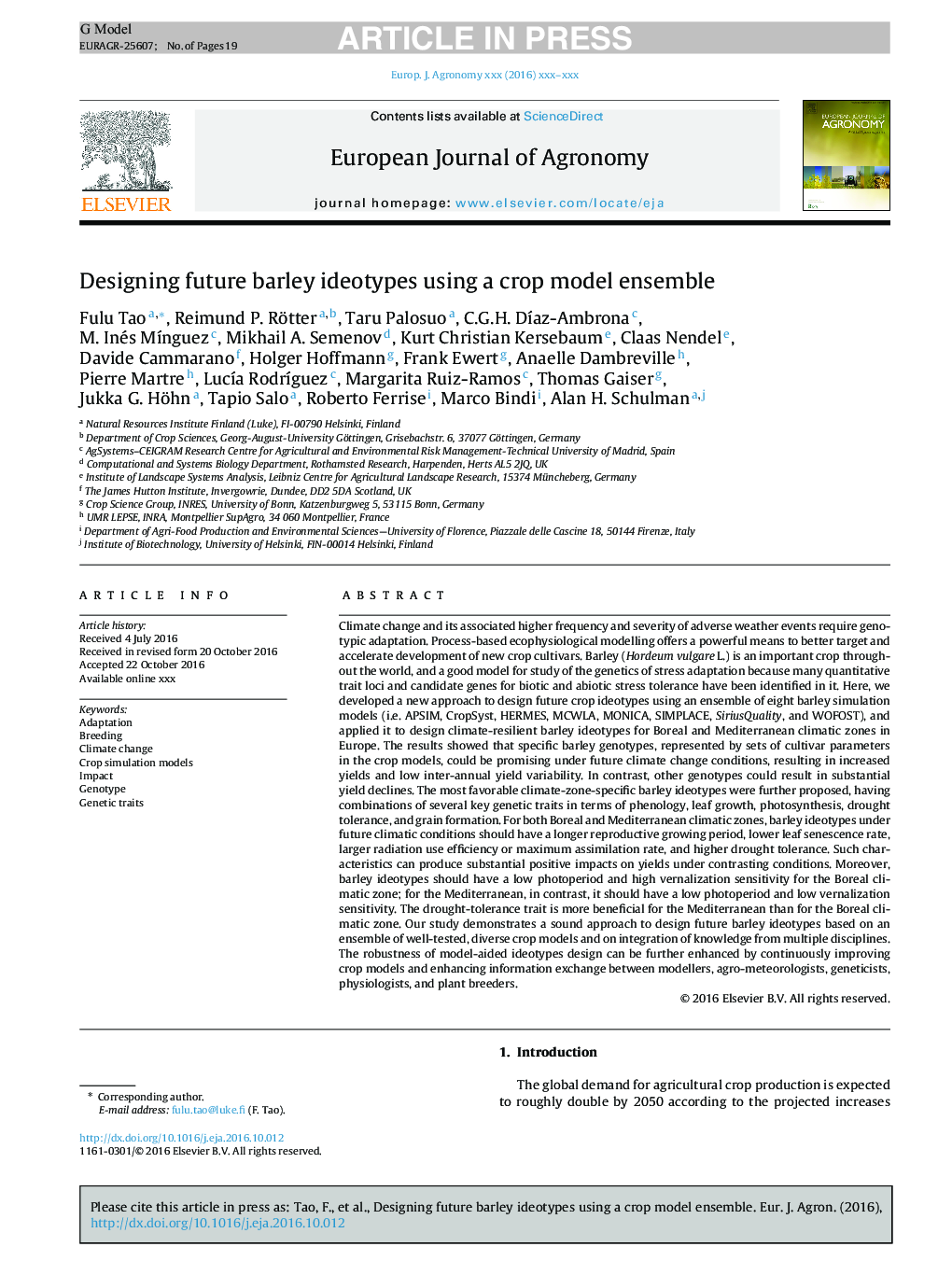| کد مقاله | کد نشریه | سال انتشار | مقاله انگلیسی | نسخه تمام متن |
|---|---|---|---|---|
| 5761333 | 1624443 | 2017 | 19 صفحه PDF | دانلود رایگان |
عنوان انگلیسی مقاله ISI
Designing future barley ideotypes using a crop model ensemble
ترجمه فارسی عنوان
طراحی ایدئوتایپ های جو در آینده با استفاده از یک مدل محصول
دانلود مقاله + سفارش ترجمه
دانلود مقاله ISI انگلیسی
رایگان برای ایرانیان
کلمات کلیدی
انطباق، پرورش، تغییر آب و هوا، مدل های شبیه سازی محصول، ضربه، ژنوتیپ، صفات ژنتیکی،
موضوعات مرتبط
علوم زیستی و بیوفناوری
علوم کشاورزی و بیولوژیک
علوم زراعت و اصلاح نباتات
چکیده انگلیسی
Climate change and its associated higher frequency and severity of adverse weather events require genotypic adaptation. Process-based ecophysiological modelling offers a powerful means to better target and accelerate development of new crop cultivars. Barley (Hordeum vulgare L.) is an important crop throughout the world, and a good model for study of the genetics of stress adaptation because many quantitative trait loci and candidate genes for biotic and abiotic stress tolerance have been identified in it. Here, we developed a new approach to design future crop ideotypes using an ensemble of eight barley simulation models (i.e. APSIM, CropSyst, HERMES, MCWLA, MONICA, SIMPLACE, SiriusQuality, and WOFOST), and applied it to design climate-resilient barley ideotypes for Boreal and Mediterranean climatic zones in Europe. The results showed that specific barley genotypes, represented by sets of cultivar parameters in the crop models, could be promising under future climate change conditions, resulting in increased yields and low inter-annual yield variability. In contrast, other genotypes could result in substantial yield declines. The most favorable climate-zone-specific barley ideotypes were further proposed, having combinations of several key genetic traits in terms of phenology, leaf growth, photosynthesis, drought tolerance, and grain formation. For both Boreal and Mediterranean climatic zones, barley ideotypes under future climatic conditions should have a longer reproductive growing period, lower leaf senescence rate, larger radiation use efficiency or maximum assimilation rate, and higher drought tolerance. Such characteristics can produce substantial positive impacts on yields under contrasting conditions. Moreover, barley ideotypes should have a low photoperiod and high vernalization sensitivity for the Boreal climatic zone; for the Mediterranean, in contrast, it should have a low photoperiod and low vernalization sensitivity. The drought-tolerance trait is more beneficial for the Mediterranean than for the Boreal climatic zone. Our study demonstrates a sound approach to design future barley ideotypes based on an ensemble of well-tested, diverse crop models and on integration of knowledge from multiple disciplines. The robustness of model-aided ideotypes design can be further enhanced by continuously improving crop models and enhancing information exchange between modellers, agro-meteorologists, geneticists, physiologists, and plant breeders.
ناشر
Database: Elsevier - ScienceDirect (ساینس دایرکت)
Journal: European Journal of Agronomy - Volume 82, Part A, January 2017, Pages 144-162
Journal: European Journal of Agronomy - Volume 82, Part A, January 2017, Pages 144-162
نویسندگان
Fulu Tao, Reimund P. Rötter, Taru Palosuo, C.G.H. DÃaz-Ambrona, M. Inés MÃnguez, Mikhail A. Semenov, Kurt Christian Kersebaum, Claas Nendel, Davide Cammarano, Holger Hoffmann, Frank Ewert, Anaelle Dambreville, Pierre Martre, LucÃa RodrÃguez,
